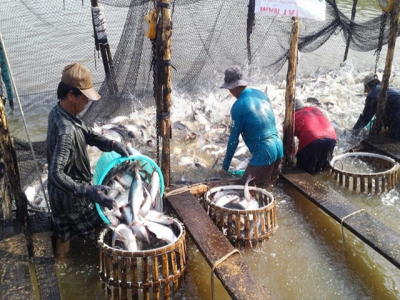Vietnams catfish now has to compete fiercely in world market

Vietnam is no longer the only catfish producer and exporter in the world and now has to compete with many rivals, including Indonesia, India and China.
The US-initiated catfish inspection program, plus the anti-dumping duty, have affected Vietnam’s catfish exports in the US.
Vietnam’s catfish now has to compete fiercely in world market
According to the Vietnam Association of Seafood Exporters and Producers (VASEP), Vietnam’s catfish exports to the US in the first nine months of the year totalled $210 million only, a sharp decrease of 44 percent compared with the same period last year.
In such a stalemate, good news has come that the US Department of Agriculture has recognized Vietnam’s food safety control system on catfish as equivalent to American regulations.
Nguyen Nhu Tiep, head of Nafiqad (the National Agro-Forestry-Fisheries Quality Assurance Department), said with the US recognition, Vietnam’s catfish industry has overcome big barriers, from the 2014 Farm Bill and the catfish inspection program, issued in March 2016.
The US-initiated catfish inspection program, plus the anti-dumping duty, have affected Vietnam’s catfish exports in the US.
According to Tiep, the US is a choosy market, which even sets stricter requirements than the EU and Japan. Therefore, once overcoming the barriers set by the US, Vietnam’s catfish will more easily access the other markets.
Difficulties facing farmers, exporters
In 2018, the catfish price escalated to the record high of VND36,000 per kilogram at some moments, which prompted farmers to rush to farm fish. The fish farming area expanded so rapidly that leaders of the Ministry of Agriculture and Rural Development (MARD) visited southern provinces, including Long An, to ‘put a brake’ on farming area expansion.
As anticipated, since the supply is abundant, the catfish price dropped dramatically to VND18,000 per kilogram. Only recently has the price begun increasing to VND21,000 per kilogram.
According to Tran Dinh Luan, general director of the General Directorate of Fisheries, in 2018, when the price increased, farmers broke contracts with processing companies and sold catfish to merchants instead of companies.
Now, as the price decreases, some companies accept to buy catfish from farmers, while others refuse to buy. As a result, farmers have to sell catfish at a loss.
Meanwhile, Vietnam is no longer the only catfish producer and exporter in the world.
Vietnam can produce 1.3 million tons of catfish a year, while the output is 650,000 tons in India, 450,000 tons in Bangladesh, and 110,000 tons in Indonesia. Even China can put out 10,000 tons of catfish.
“The countries have begun exporting their catfish, though their market shares remain small,” Luan said. “Once they increase the farming output, they will compete with Vietnam."
Vietnam needs to be ‘one step ahead’. According to Luan, Vietnam makes 100 tons of value-added products.
Related news
 Shrimp seeds need firm management
Shrimp seeds need firm management It was instructed by Deputy Minister of Agriculture and Rural Development Phùng Đức Tiến in a convention regarding shrimp seeds management
 Mitsui invests $100 million in Vietnam’s king of shrimp Minh Phu
Mitsui invests $100 million in Vietnam’s king of shrimp Minh Phu Has committed $100 million to Minh Phu Seafood Corporation – Vietnam’s largest shrimp processing company – in order to help improve its shrimp exports.
 Can algae act as a "shield" against sea lice
Can algae act as a "shield" against sea lice Researchers in Norway are investigating whether diets containing microalgae can make salmon more resistant to sea lice.
 Aquatic exports record two-digit growth in January
Aquatic exports record two-digit growth in January Vietnam raked in 700 million USD from aquatic exports in January, a year-on-year rise of 15.2 percent
 Fisheries industry sets export target of $10 billion
Fisheries industry sets export target of $10 billion The fisheries sector has set itself an export target of US$10 billion this year, the target set by the Government only for 2020